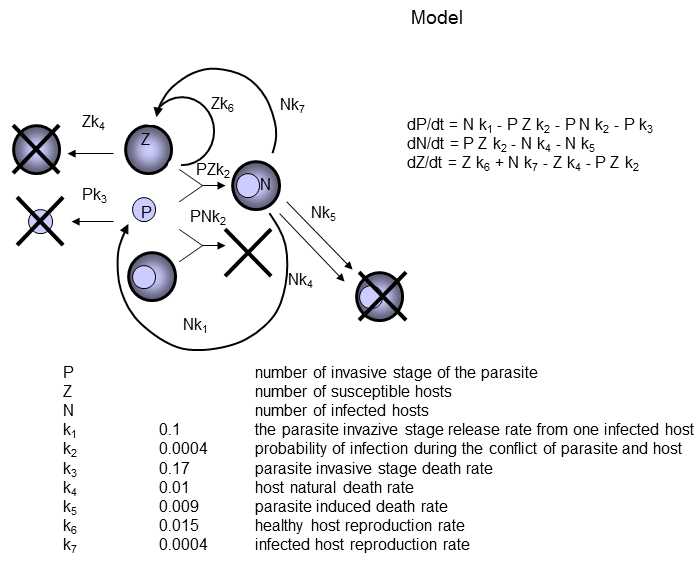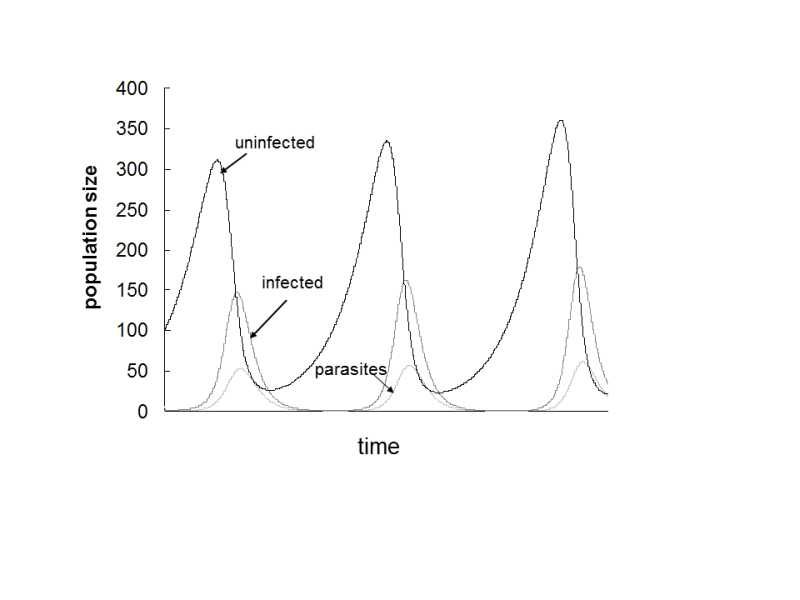XIX.1.4 A parasite must not exterminate its host species
The negative pressure of parasites on a host population can be very intense.The range of a certain parasite can even determine the area of occurrence for a particular host species.Normal, highly productive breeds of cattle (and thus larger human populations) can, for example, not survive for long in a large part of equatorial Africa as the tse-tse fly (Glossina genus) lives in this area; this fly transmits trypanosomes causing the fatal nagana disease in cattle (Moloo, Kutuza, & Boreham 1980).
Because of its faster evolution, a specialized parasite is always able to overcome the defense system of the host species.Thus, it might seem that the host does not have much chance in the evolutionary battle with the parasite.However, in fact, the situation is fortunately (for us, a host species) somewhat more favorable.While the creation of a new system of defense against parasites is unambiguously advantageous for the host, the creation of a new system of overcoming the defensive system of the host can be, in its consequences, fatal for the parasite.If its host were exterminated or if its population were to decrease under a certain critical level, the parasite would necessarily also become extinct.It is thus probable that a specialized, single-host parasite cannot completely exterminate its host without dying out itself first.The situation is different for less specialized parasites, with a broader spectrum of host species.Here a situation can apparently very frequently occur where a parasite completely exterminates a host species.Similarly, a parasite that forms and releases into the environment resistant stages, for example spores, can also exterminate its host species.A delay and subsequent oscillations occur in the parasite – host system, as the momentary level of parasitization does not reflect the momentary size of the parasite population (and thus the momentary size of the host population), but the number of spores in the environment and thus actually the size of the previous parasite population.The fluctuations in the populations of the two species can thus be chaotic or have increasing amplitude, in consequence of which, sooner or later, the specialized parasite or the parasite and its host become extinct (Fig. XIX.1 and Fig. XIX.2).

Fig. XIX.1 Model of the coexistence of a parasite and its host. In this case, the parasite infects the host and produces infectious stages which it releases into the environment. The infected host reproduces (at a lower rate than uninfected individuals) but the offspring are not infected. The infected hosts also die and thus the infectious stages of the parasite also die at a certain rate. If the parasite infects an already infected host, the production of infectious stages does not increase (this is thus a microparasite). In dependence on the values of the individual parameters of the model, damped and undamped fluctuations can occur in the system, or a stable state can be attained, in which the parasite and the host coexist in a constant ratio.

Fig. XIX.2 Model of the coexistence of a parasite and its host. The graph depicts the trends in the populations of a parasite and its host if the parameters of the system are adjusted as depicted in Fig. XIX.1. In this case, fluctuations with increasing amplitude occur in the system.
